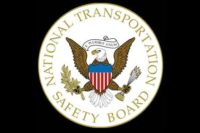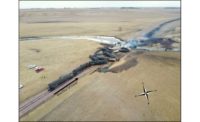 The National Transportation Safety Board (NTSB) recommended that the type of tank car involved in the recent Canadian train derailment and inferno be retrofitted or phased out of use because it was unsafe, according to Board records.
The National Transportation Safety Board (NTSB) recommended that the type of tank car involved in the recent Canadian train derailment and inferno be retrofitted or phased out of use because it was unsafe, according to Board records.
The death toll in the July 7 accident in Lac-Megantic, Quebec accident stands at 33, although 17 people are still missing and presumed dead. The train, which was carrying oil, came loose from its overnight parking spot and traveled seven miles downhill before derailing on a curve and crashing into a number of buildings, erupting into a fireball.
The Transportation Safety Board of Canada is investigating the accident.
The DOT-111 rail car involved in the accident is in widespread use in North America, particularly for the transportation of hazardous materials.
Design flaws
An NTSB investigation into the 2009 derailment of a freight train in Cherry Valley, Illinois that caused a fatality and fire and released hazardous materials concluded that the spill was likely made worse by design flaws in the DOT-111 rail car involved in that accident.
The agency said the “inadequate design” of the DOT-111s made them “subject to damage and catastrophic loss of hazardous materials” and noted that other models of rail cars have thicker shells than the DOT-111, offering more protection when carrying high pressure cargo. Thirteen of the 15 tank cars that piled up in the accident “lost product from head and shell breaches or through damaged valves and fittings,” according to the NTSB. “This represents an overall failure rate of 87 percent and illustrates the continued inability of DOT-111 tank cars to withstand the forces of accidents.”
The agency recommended that all DOT-111s be be retrofitted to reduce the possiblity of leaks or spills or phased out.
Safer rail cars in the future
DOT-111 rail cars ordered after October 2011 have been manufactured to the new code, but the industry has reportedly resisted spending an estimated $1 billion to retrofit the nearly 300,000 tank cars which are currently in use.



